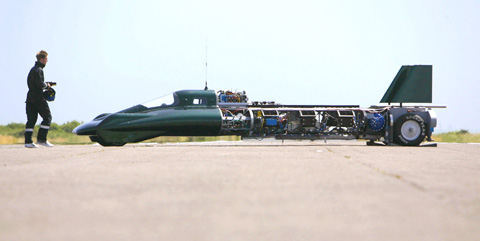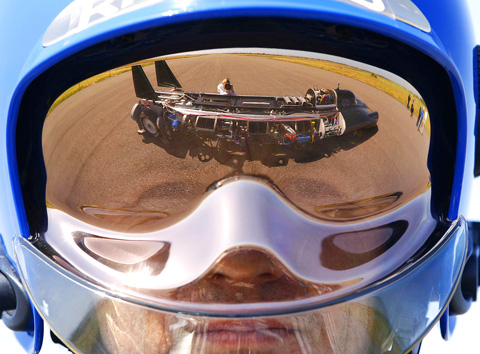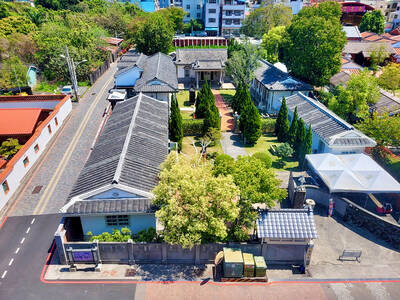Front on, the vehicle could be mistaken for a nifty sports car, and from the rear it looks like something out of a low-budget science fiction show, all jutting Thunderbirds fins. But the side view is the crucial one — a puzzling mishmash of tubes and wires and water tanks.
This is Inspiration, a steam-powered car built in the UK — in a wooden workshop in the New Forest, Hampshire, in southern England, to be precise — believed by its designers to be capable of smashing the oldest land speed record.
In August, on the Bonneville salt flats of Utah in the US, superheated steam will rush through almost 3.2km of the car’s tubing and propel the vehicle at 282km, a speed that would smash the steam car record of 206km, established more than a century ago.

PHOTO: AP
All in all, it is a very British kind of project, a mixture of eccentric dreams and clever, patient engineering: a combination of the hi-tech (it has taken brilliant technical know-how to design tubing able to withstand the sort of heat and pressure that will be generated) and the homespun (an ordinary camping stove valve turns out to be a vital component in the ignition system).
The project has fallen a few weeks behind schedule, and at the unveiling of Inspiration on Wednesday, plans to fire the engine up were shelved following a bent valve earlier in the week. So the team pushed the vehicle into position on a windswept military runway in Hampshire, where the final test runs will happen before the car crosses the Atlantic.
In an army tent the engineer, Matt Candy, explained how Inspiration works. Liquid petroleum gas is used to raise steam in the 7m-long car. The gas is set alight using an ordinary car ignition system — and that valve pinched from a camping stove. A wall of flame at a temperature of more than 1,000°C is created and used to heat a tonne of water. The water passes through the car’s tubes and turns into superheated steam. The steam, at 400°C, hits a turbine and turns a shaft, which makes the wheels go round. Should anyone be finding it hard to imagine this sort of heat and power, the boffins help out, in a very British way. You could, apparently, make 23 cups of tea a second with that sort of heat.

PHOTO: AP
In Utah it will take 4.2km to get this hurtling kettle up to top speed. The car will then travel at about 274kph for 1.6km before being allowed to grind slowly to a halt over another 1.6km.
Because the record requires two runs, the team will turn Inspiration round, get her all steamed up again and do another 11km. The average speed of the two runs is what counts.
Steam cars used to be quite the thing. In 1906, Fred Marriott, an American, drove one that reached 205kph. Then the combustion engines took over and today jet-powered monsters dominate the land speed record books. Marriott’s achievement remains the longest-standing land speed record recognize by the Federation International de l’Automobile.
But Candy insisted steam could have a future. “I’m not saying we’re all going to be driving steam cars but the technology could have other uses,” he said.
The team has been in talks with firefighting experts, since steam can have uses in tackling blazes. Candy also wonders if steam might have a use in aircraft technology as the search for greener fuels intensifies.
The Inspiration team certainly has speed aristocracy on its side. Its test driver is Don Wales, the nephew of Donald Campbell and grandson of Malcolm Campbell, who between them set more than 20 speed records on land and water.
“This project has got all of the things that make us Brits great,” said Wales. “It’s got the quirkiness of a homespun project but it’s also got serious engineering. My grandfather and uncle, hopefully, would be proud and impressed that we are trying to keep up the family tradition of breaking records and keeping records in Britain, which was their main goal in life.”
Wing Commander Andy Green, a British air force fighter pilot and the holder of the world land speed record (a mere 1,228kph) turned up to lend his support. “We don’t know what these guys are going to learn as they develop this car. It’s almost a home science project, in the same way that Orville and Wilbur Wright in 1903 were running a home science project. Look what they achieved.”
And should another valve bend at an inopportune moment, the Inspiration team might at least be able to console themselves with endless cups of tea.

April 28 to May 4 During the Japanese colonial era, a city’s “first” high school typically served Japanese students, while Taiwanese attended the “second” high school. Only in Taichung was this reversed. That’s because when Taichung First High School opened its doors on May 1, 1915 to serve Taiwanese students who were previously barred from secondary education, it was the only high school in town. Former principal Hideo Azukisawa threatened to quit when the government in 1922 attempted to transfer the “first” designation to a new local high school for Japanese students, leading to this unusual situation. Prior to the Taichung First

Chinese Nationalist Party (KMT) Chairman Eric Chu (朱立倫) hatched a bold plan to charge forward and seize the initiative when he held a protest in front of the Taipei City Prosecutors’ Office. Though risky, because illegal, its success would help tackle at least six problems facing both himself and the KMT. What he did not see coming was Taipei Mayor Chiang Wan-an (將萬安) tripping him up out of the gate. In spite of Chu being the most consequential and successful KMT chairman since the early 2010s — arguably saving the party from financial ruin and restoring its electoral viability —

The Ministry of Education last month proposed a nationwide ban on mobile devices in schools, aiming to curb concerns over student phone addiction. Under the revised regulation, which will take effect in August, teachers and schools will be required to collect mobile devices — including phones, laptops and wearables devices — for safekeeping during school hours, unless they are being used for educational purposes. For Chang Fong-ching (張鳳琴), the ban will have a positive impact. “It’s a good move,” says the professor in the department of

Toward the outside edge of Taichung City, in Wufeng District (霧峰去), sits a sprawling collection of single-story buildings with tiled roofs belonging to the Wufeng Lin (霧峰林家) family, who rose to prominence through success in military, commercial, and artistic endeavors in the 19th century. Most of these buildings have brick walls and tiled roofs in the traditional reddish-brown color, but in the middle is one incongruous property with bright white walls and a black tiled roof: Yipu Garden (頤圃). Purists may scoff at the Japanese-style exterior and its radical departure from the Fujianese architectural style of the surrounding buildings. However, the property